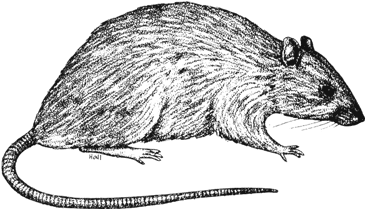Family Owned and Operated Pest Control Experts Servicing the San Francisco Bay Area
Pest Education: Rats
Rodents can damage structures by their gnawing and burrowing, contaminate food,
as well as spread disease that can affect humans and livestock.
The two most common rats in Northern California are the Norwegian Brown, and the Roof Rat. Rats can be detected by their droppings or evidence of gnawing and rub marks; their tracks can be seen in the mud and on dusty surfaces.
Burrows and runways can be found near buildings, by creek beds and drainage ditches as well as along fences and under low vegetation and debris.
About Roof Rats & Norway Rats:
The Roof Rat is dark brown to black in color and measures 13 to 18 inches in length including their long tail. They weigh 5-9 ounces, are slender, and their ears are large and nearly hairless. Their droppings are long and cylindrical. Norway Rats are robust rodents that usually weigh about 11 ounces. Adults are 13 to 18 inches long, including a 6- to 9-inch tail. Their fur is coarse, brownish and scattered with black hair on the upper surfaces. The fur on the belly is typically gray to yellowish-white, and they have a naked, scaly tail.
Rats will eat nearly anything consumed by human beings, as well as on a variety of other organic materials, fresh grain, vegetation and meat. Rats will need 1 fluid ounce of water daily when feeding on dry food. Rats have acute senses of hearing, smell, taste and touch. Rodents are highly social animals and use many of their senses to communicate with one another. They will climb to find food or shelter and gain entrance to a building, they can fit through any opening larger then ½ inch in diameter or about the size of a quarter. They have litters of six to 12 young which are born 21 to 23 days after mating. Young rats are able to mate at about three months of age. Breeding occurs mostly in spring and fall. The average female has four to six litters per year; individuals live approximately 12 to 18 months.

How You Can Prevent Rodent Infestations
To control rodents, in addition to rodent baits, traps & glue boards, there are a number of things that can be done to either prevent a rodent problem or to enhance a rodent bait/trapping program.
-
It is important to trim tree branches 5’ from buildings and trim bushes or ground cover 12” back from the foundation.
-
All vents & screens must be covered and in good repair.
-
Seal as many holes and access area, cracks & crevices as possible with steel wool or expansion foam.
-
The presence of garbage and other refuse allows rats to exist in residential area.
-
Good sanitation will not completely eliminate rats under all conditions but will make the environment less hospitable for them to live and thrive.
-
This involves proper storage and handling of food materials and garbage.
-
Keeping your yard and home free of an overabundance of clutter and trash.
-
Feeding of other wildlife such as squirrels and birds is a very easy food source for rodents.
-
Always pick up pet food when your pet is done eating
-
Rinse and store recyclable cans and bottles in closed- lid containers.
Sanitation and exclusion are the two of the biggest factors in preventing rat infestation problems. If rodents become a problem there are a variety of control methods, including baiting and trapping. Call California American Exterminator today for all of your rodent control needs.

Information partially adapted from the University of Nebraska and the City of Chandler Arizona websites.
Facts About Norway Rats

Name: The brown rat, also referred to as common rat, street rat, sewer rat, Hanover rat, Norway rat, brown Norway rat,Norwegian rat, or wharf rat (Rattus norvegicus) is one of the best known and most common rats.
Apperance: The fur is coarse and usually brown or dark grey, while the underparts are lighter grey or brown. The brown rat is a rather large true murid and can weigh twice as much as a black rat and many times more than a house mouse.
Size: One of the largest muroids; the male weighs on average 350 g (12 oz) and the female 250 g (9 oz). The length is commonly in the range of 20 to 25 cm (8 to 10 in), with the tail a further 18 to 25 cm (7 to 10 in), thus being roughly the same length as the body.
Dangers: Similar to other rodents, brown rats may carry a number of pathogens, which can result in disease, including Weil's disease, rat bite fever, cryptosporidiosis, viral hemorrhagic fever, Q fever and hantavirus pulmonary syndrome.
